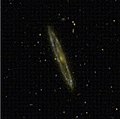NGC 4216
| NGC 4216 | |
|---|---|
 | |
| Observation data (J2000 epoch) | |
| Constellation | Virgo |
| Right ascension | 12h 15m 54.4s[1] |
| Declination | +13° 08′ 58″[1] |
| Redshift | 131 ± 4 km/s[1] |
| Distance | 55 Mly[2] |
| Apparent magnitude (V) | 11.0[1] |
| Characteristics | |
| Type | SAB(s)b[1] |
| Apparent size (V) | 8′.1 × 1′.8[1] |
| Other designations | |
| UGC 7284,[1] PGC 39246, VCC 167[1] | |
NGC 4216 is a metal-rich[2] intermediate spiral galaxy located not far from the center of the Virgo Cluster[2] of galaxies, roughly 55 million light-years away.[2] It is seen nearly edge-on.
Physical characteristics
NGC 4216 is one of the largest and brightest spiral galaxies of the Virgo Cluster, with an absolute magnitude that has been estimated to be −22 (i.e.: brighter than the Andromeda Galaxy),[3] and like most spiral galaxies of this cluster shows a deficiency of neutral hydrogen that's concentrated within the galaxy's optical disk and has a low surface density for a galaxy of its type.[4] This explains why NGC 4216 is considered an anemic galaxy by some authors, also with a low star formation activity for a galaxy of its type.[5] In fact, the galaxy's disk shows pillar-like structures that may have been caused by interactions with the intracluster medium of Virgo and/or with nearby galaxies.[6]
In NGC 4216's halo, besides a rich system of globular clusters with a number of them estimated in around 700 (nearly five times more than the Milky Way),[3] two stellar streams that are interpreted as two satellite galaxies being disrupted and absorbed by this galaxy are present.[6]
NGC 4216 seems to be in a place of the Virgo cluster where dwarf galaxies are being destroyed/accreted at a high rate, with it suffering many interactions with these type of galaxies.[7]
Gallery
-
NGC 4216 by Sloan Digital Sky Survey
-
An ultraviolet image of NGC 4216 by GALEX
References
- ^ a b c d e f g h "NASA/IPAC Extragalactic Database". Results for NGC 4216. Retrieved 2006-11-25.
- ^ a b c d O'Meara, Stephen James (2007). Deep-Sky Companions: Hidden Treasures. Cambridge University Press. pp. 299–302. ISBN 9780521837040.
- ^ a b "Globular Cluster Systems in Galaxies Beyond the Local Grup". NASA-IPAC Extragalactic Database (NED). Retrieved 2012-07-21.
- ^ Chung, A.; Van Gorkom, J.H.; Kenney, J.F.P.; Crowl, Hugh; Vollmer, B. (2009). "VLA Imaging of Virgo Spirals in Atomic Gas (VIVA). I. The Atlas and the H I Properties". The Astronomical Journal. 138 (6): 1741–1816. Bibcode:2009AJ....138.1741C. doi:10.1088/0004-6256/138/6/1741.
- ^ Vollmer, B.; Soida, M.; Beck, R.; Chung, A.; Urbanik, M.; Chyży, K. T.; Otmianowska-Mazur, K.; Kenney, J. D. P. (2013). "Large-scale radio continuum properties of 19 Virgo cluster galaxies. The influence of tidal interactions, ram pressure stripping, and accreting gas envelopes". Astronomy & Astrophysics. 553: 1741–1816. arXiv:1304.1279. Bibcode:2013A&A...553A.116V. doi:10.1051/0004-6361/201321163. S2CID 119190841. A116.
- ^ a b "Stellar Tidal Streams in Spiral Galaxies of the Local Volume". Retrieved 2012-07-21.
- ^ Paudel, Sanjaya; Duc, Pierre-Alain; Côté, Patrick; Cuillandre, Jean-Charles; et al. (2013). "The Next Generation Virgo Cluster Survey. IV. NGC 4216: A Bombarded Spiral in the Virgo Cluster". Astrophysical Journal. 767 (2): 133. arXiv:1302.6611. Bibcode:2013ApJ...767..133P. doi:10.1088/0004-637X/767/2/133. S2CID 118421922. 133.
External links
 Media related to NGC 4216 at Wikimedia Commons
Media related to NGC 4216 at Wikimedia Commons


